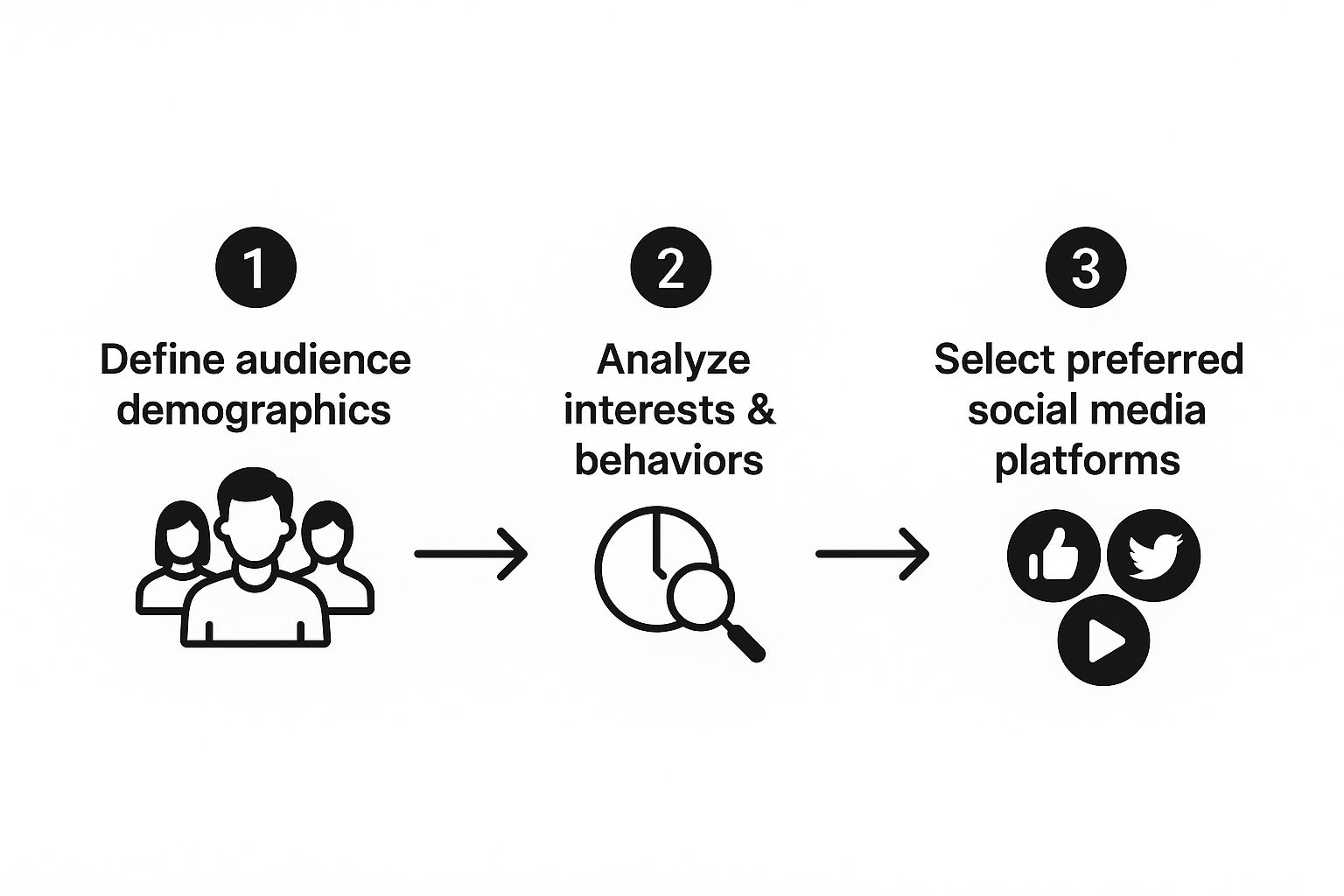
A Social Media Campaign Template That Actually Works
Published
Trying to kick off a new social media campaign from scratch can feel overwhelming. Staring at that blank document? We've all been there. This is where a solid social media campaign template comes in—it’s less of a document and more of a strategic command center. It's what takes you from scrambling with last-minute posts to executing a polished, goal-driven strategy.
Why a Template Is Your Campaign's Secret Weapon
Think of a good template as the foundation for your entire campaign. It’s the critical difference between just filling up a content calendar and actually building a campaign that brings in real, measurable results for your business. It provides a reliable framework to turn those brilliant-but-vague ideas into a concrete, actionable plan.
More importantly, a structured approach ensures every single effort is deliberate and directly tied to your main objectives. This not only saves a ton of time but also helps you sidestep costly mistakes by making sure every piece of content has a clear purpose.
From Chaos to Cohesion
Let's be honest: without a template, campaign planning can quickly devolve into a reactive mess. Ideas are scribbled on notepads, goals are fuzzy, and the final execution feels completely disjointed.
A template forces you to shift into a proactive mindset. It makes you sit down and think through all the crucial pieces before you even think about writing a single post.
This is where having a social media marketing plan template really becomes your campaign's secret weapon. It streamlines everything from setting initial objectives all the way through to final reporting, giving you a single source of truth for the whole team.
Here’s a quick look at the non-negotiable elements every effective social media campaign template should have.
Essential Parts of a High-Impact Campaign Template
| Component | Its Strategic Purpose |
|---|---|
| Clear Objectives | Defines what success looks like beyond just likes and followers. Think leads, sales, or sign-ups. |
| Audience Personas | Creates a crystal-clear picture of who you're talking to—their needs, wants, and online habits. |
| Core Messaging | Establishes the central narrative and key talking points that will echo through all your content. |
| Content Pillars | Sets up the main themes or topics that will guide your content creation, ensuring consistency. |
By mapping these elements out first, you create a North Star for your campaign that everyone can follow.
A Framework for Success
Using a template isn't about stifling your creativity—it's about focusing it where it counts. Research consistently shows that brands with a documented social media strategy are far more likely to hit their marketing goals simply because they have a clear roadmap. This organized approach walks you through defining sharp SMART goals, planning a steady stream of content, and keeping your messaging on point.
The real magic of a template is that it builds strategic habits. It forces you to ask "why" before you ever decide "what," ensuring your social media efforts are always connected to tangible business outcomes.
Setting Objectives That Drive Real Business Value
A campaign without a clear purpose is just noise. If you want your social media efforts to actually move the needle for your business, you need to look past simple vanity metrics like follower counts and focus on goals that matter. A solid campaign template will force you to get specific about what success really looks like from the get-go.

This is where I always lean on the SMART framework—it’s a classic for a reason. Making your goals Specific, Measurable, Achievable, Relevant, and Time-bound is non-negotiable. It’s the difference between a vague wish and a concrete plan.
For example, "increase brand awareness" is a common but weak objective. It's not measurable. A much stronger, SMART objective would be: "Achieve a 40% increase in branded search queries and a 15% lift in direct website traffic from social channels in Q2."
See the difference? One is a hope, the other is a plan.
Connecting Goals to Meaningful KPIs
Once you've locked in your main objective, the next logical step is to connect it to the right Key Performance Indicators (KPIs). Think of KPIs as the signposts that tell you whether you're on the right road to achieving your goal. A good template should have a spot to map these out clearly.
The KPIs you choose will be entirely different depending on your objective. A campaign designed to generate leads, for instance, will look very different from one aimed at building a community.
- For Lead Generation: I’d be watching Cost Per Acquisition (CPA), Conversion Rate, and the number of Form Fills like a hawk.
- For Brand Awareness: The focus shifts to Reach, Impressions, and Audience Sentiment.
- For Engagement: It's all about Comments, Shares, and brand Mentions.
Your goal is to draw a straight line from your day-to-day social media activities to your company's bottom line. When your boss asks if the campaign worked, your KPIs should give you a clear, data-driven answer.
With global social media ad spend projected to reach $276.7 billion, just "posting and praying" isn't a strategy. Having a structured plan built around precise KPIs is the only way to make sure your budget is working as hard as you are.
Choosing the right metrics is absolutely fundamental to proving the value of your work. If you're struggling to decide what to track, our guide on essential social media engagement metrics can help you zero in on the KPIs that will tell the most accurate story about your campaign’s performance.
Building Your Campaign Content and Calendar
Alright, this is where the rubber meets the road. Your template is about to go from a strategic outline to a living, breathing action plan. We're moving beyond goals and into the nitty-gritty of creating the content that will actually get you there. The key is to build a cohesive story, not just a bunch of random posts.
First things first, let's define your content pillars. These are the 2-4 core themes your campaign will circle back to again and again. Think of them as the main chapters of your campaign's story. For instance, if you're launching a new fitness app, your pillars could be Workout Tutorials, Nutrition Tips, and User Success Stories. This keeps your messaging tight and focused.
Crafting Your Content Mix
A huge mistake I see brands make is just pushing their products all day. That's a surefire way to get unfollowed. You need to mix it up to keep people interested and build a real connection.
Here's how to think about balancing your content:
- Educational Content: Give them something valuable. Think quick tips, how-to guides, or interesting industry stats.
- Entertaining Content: Show some personality! This could be a funny meme, a behind-the-scenes look at your office, or a relatable story.
- Community-Driven Content: Make your audience the hero. Share user-generated content (UGC), run a poll, or host a live Q&A.
- Promotional Content: When it's time to sell, focus on the benefits. Don't just list features; explain how your product solves a problem.
Once you have your pillars and your mix in mind, it's time to plot it all out. Learning how to create a content calendar is non-negotiable here; it turns your big ideas into a daily to-do list.
Pro Tip: I live by the 80/20 rule. About 80% of my content is designed to educate, entertain, or engage the community. Only the remaining 20% is directly promotional. This approach has consistently built more trust and kept audiences around for the long haul.
Your template should have dedicated spots for the date, time, platform, content pillar, post format (like a Reel or carousel), the caption, and any visuals. This creates a predictable workflow but still gives you the flexibility to jump on trends or current events. Later on, all this organized data makes reporting a breeze. You can even see how a social media analytics report template is structured to pull this info together effectively.
This infographic breaks down some of the initial thinking that should guide your content decisions.

Following this process ensures every piece of content you create is strategic, intentional, and hits the right audience on the right platform.
Budgeting and Allocating Your Resources Wisely
Let's be honest: no great campaign ever happened without a smart financial plan backing it up. This is where your social media campaign template becomes your financial command center. It helps you map out, manage, and track every dollar, ensuring nothing goes to waste. If you skip budgeting, you're just guessing, and that’s a quick way to burn through cash on activities that don’t move the needle.

First things first, let's list out all the potential costs. It's easy to just think about ad spend, but the real costs go much deeper. I’ve seen budgets blow up because people forgot about the less obvious expenses.
- Ad Spend: This is the most straightforward part—the money you're putting directly into platforms like Meta, TikTok, or LinkedIn to boost your content.
- Content Creation: What does it cost to actually make the stuff you're promoting? Think about graphic design work, video shoots and editing, professional photography, or even hiring a great copywriter.
- Influencer Partnerships: If you're working with creators, you need to account for their fees. This can range from a few hundred to thousands of dollars depending on their reach.
- Software & Tools: Don't forget the monthly subscriptions for the tools that make your life easier. This includes schedulers, analytics platforms, or design software like Canva or Adobe Creative Cloud.
Aligning Your Budget with Your Goals
Now, here’s where the strategy comes in. Your budget allocation should be a direct reflection of your campaign's main objective. Don't just slice the pie into even pieces. You need to put your money where it will have the biggest impact on your specific goal.
For instance, if you're running a lead generation campaign for a B2B software company, you’ll probably want to put a hefty chunk of your budget into LinkedIn Ads and maybe some Meta Lead Forms. The audience is right there.
On the flip side, if you're launching a new energy drink and your goal is pure brand awareness, your spending will look completely different. You'd be better off investing in high-energy, eye-catching video content for TikTok and Instagram Reels to capture as many eyeballs as possible.
A well-structured budget is a strategic document, not just a spreadsheet. It tells the story of your campaign’s priorities and provides a clear framework for making data-driven spending decisions.
By keeping a running tally of your expenses right inside your template, you stay in the driver's seat. You can see in real-time if a particular channel isn't performing. This gives you the power to pivot on a dime, pulling funds from what's not working and pushing them toward what is, making sure every single dollar is working as hard as it can for you.
How to Track Performance and Report on What Matters
Once your campaign goes live, the game changes. Your social media template shifts from being a planning document to your command center for tracking performance. This is where the real work—and the real learning—begins. You’re no longer just forecasting success; you're actively measuring it to make sure every dollar and every minute spent is making a difference.

The first thing you’ll want to do is start plugging real numbers into the reporting section of your template. Pull the data straight from each platform's native analytics or any third-party tools you’re using. By keeping everything in one place, you get a clear, side-by-side view of crucial metrics like engagement, reach, impressions, website traffic, and, most importantly, conversions. This makes it so much easier to see what's actually working.
Focus on Actionable Insights, Not Vanity Metrics
It's tempting to get caught up in big, flashy numbers like follower counts or total impressions. We’ve all been there. While those numbers can feel good, they rarely tell you what’s truly impacting your business goals. Actionable metrics are where the real story is.
Let's look at an example:
- Vanity Metric: A post got 10,000 likes. (Nice, but what did it do?)
- Actionable Metric: That same post drove 250 clicks to our landing page, which had a 4% conversion rate and generated 10 solid new leads.
See the difference? The second metric gives you a tangible return on investment. It also gives you a starting point for figuring out why that post was so successful. Was it the sharp copy? The killer visual? A perfectly timed call-to-action? Answering those questions is how you turn a one-off win into a repeatable strategy. If you want to get better at this, check out our guide on https://influencermarketingjobs.net/blog/how-to-measure-content-performance.
Your report shouldn't just be a list of what happened. It needs to tell the story of why it happened and lay out a clear plan for what to do next. Think of your template as a tool for data-driven storytelling.
When you present your findings to your team or to clients, use the template to build a simple, visual summary. Start with the KPIs you agreed on from the beginning, show them the actual results, and finish with clear recommendations backed by the data you’ve collected. Exploring marketing analytics can provide even deeper insights into this process. This approach proves your value and turns a simple report into a powerful roadmap for what comes next.
Answering Your Top Questions About Campaign Templates
https://www.youtube.com/embed/NwZy0evRnZs
Even with a great template in hand, you're bound to have questions. Let's be honest, adopting any new process can feel a little strange at first. Drawing from my own experience and countless conversations with other marketers, I've gathered answers to some of the most common concerns people have when they start using a campaign template.
"Will a Template Stifle My Creativity?"
I hear this one a lot, and it's a valid concern. But here's the reality: a well-designed template actually does the opposite. Think of it this way—it takes care of the boring, structural stuff for you.
By mapping out the core strategy, your goals, and how you’ll measure success, the template frees up your brainpower. Instead of getting bogged down in administrative details, you can pour all that creative energy into what really matters: developing knockout content that genuinely connects with your audience.
"Can One Template Really Work for All Social Platforms?"
This is another great question. The answer is yes… and no. The strategic heart of your campaign—your primary objectives, your target audience, your core messaging—should be consistent everywhere. That's the part your template keeps aligned.
However, the execution will absolutely change from platform to platform. A killer TikTok strategy looks very different from a winning Instagram or LinkedIn plan. Your template should be flexible enough to account for these differences. You can create sections or notes for platform-specific details like:
- Video length requirements
- Optimal image dimensions
- Hashtag strategies
- Community-specific tones of voice
How Often Should I Update My Template?
This is critical: your campaign template is not a "set it and forget it" document. It's a living, breathing guide that should evolve with your campaign. You should be in it constantly.
A simple rhythm I've found effective is a quick weekly check-in to monitor your pacing and a more in-depth monthly review to dig into performance data. This lets you make smart adjustments based on real results, not just assumptions.
Sticking to a rigid plan that isn't delivering is one of the fastest ways to waste your budget and effort. For example, let's say after two weeks you see your Instagram Reels are driving 50% more engagement than your static image posts. That's a clear signal. You should immediately adjust your template’s content calendar to prioritize creating more Reels.
This kind of agility is what separates a good campaign from a great one. It turns your template from a static plan into your secret weapon for continuous improvement.
Ready to find your next role in the fast-paced world of social media and content strategy? Influencer Marketing Jobs is the premier job board for professionals just like you. Explore hundreds of opportunities from leading brands and agencies. Find your dream marketing job today!